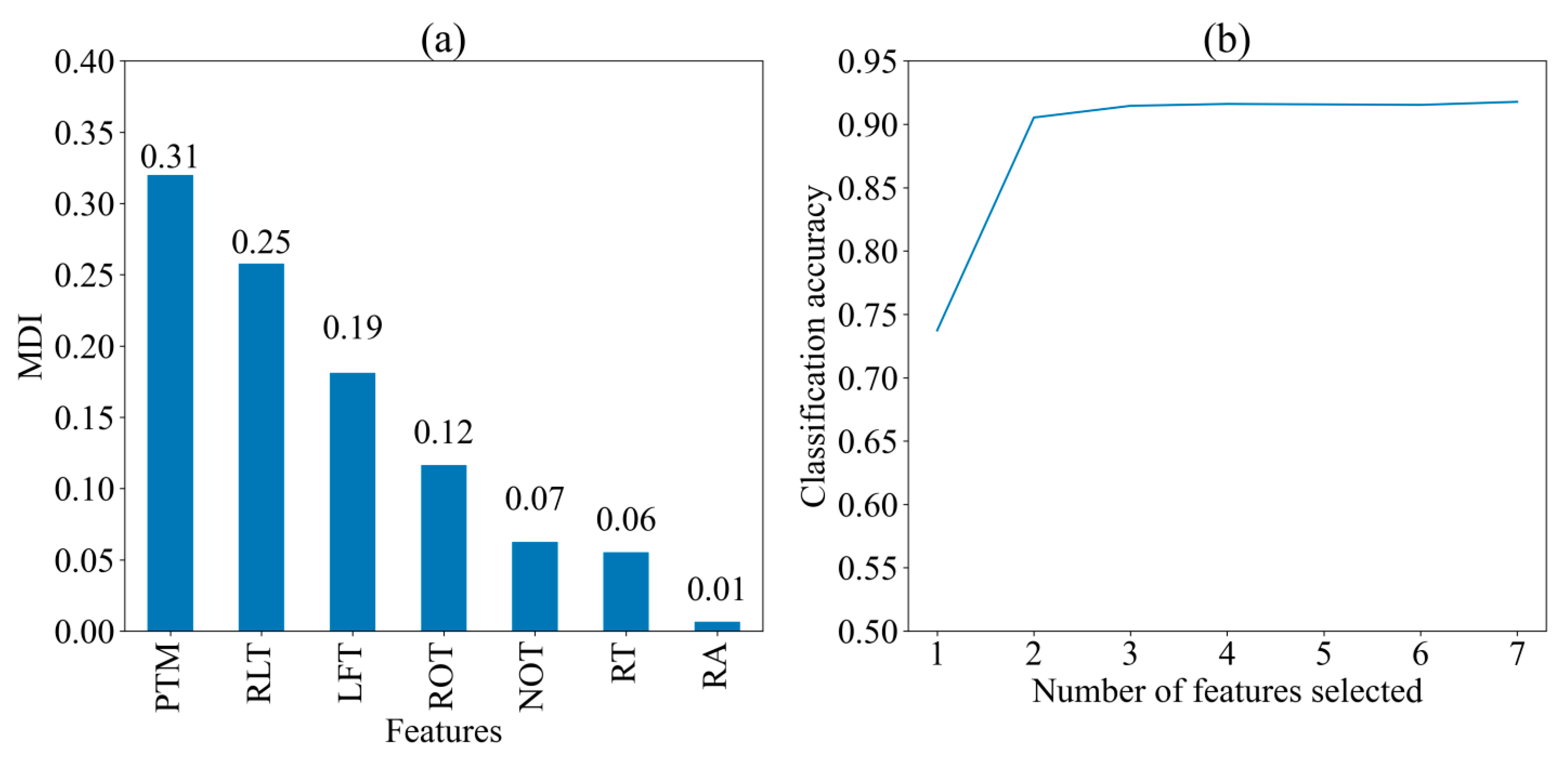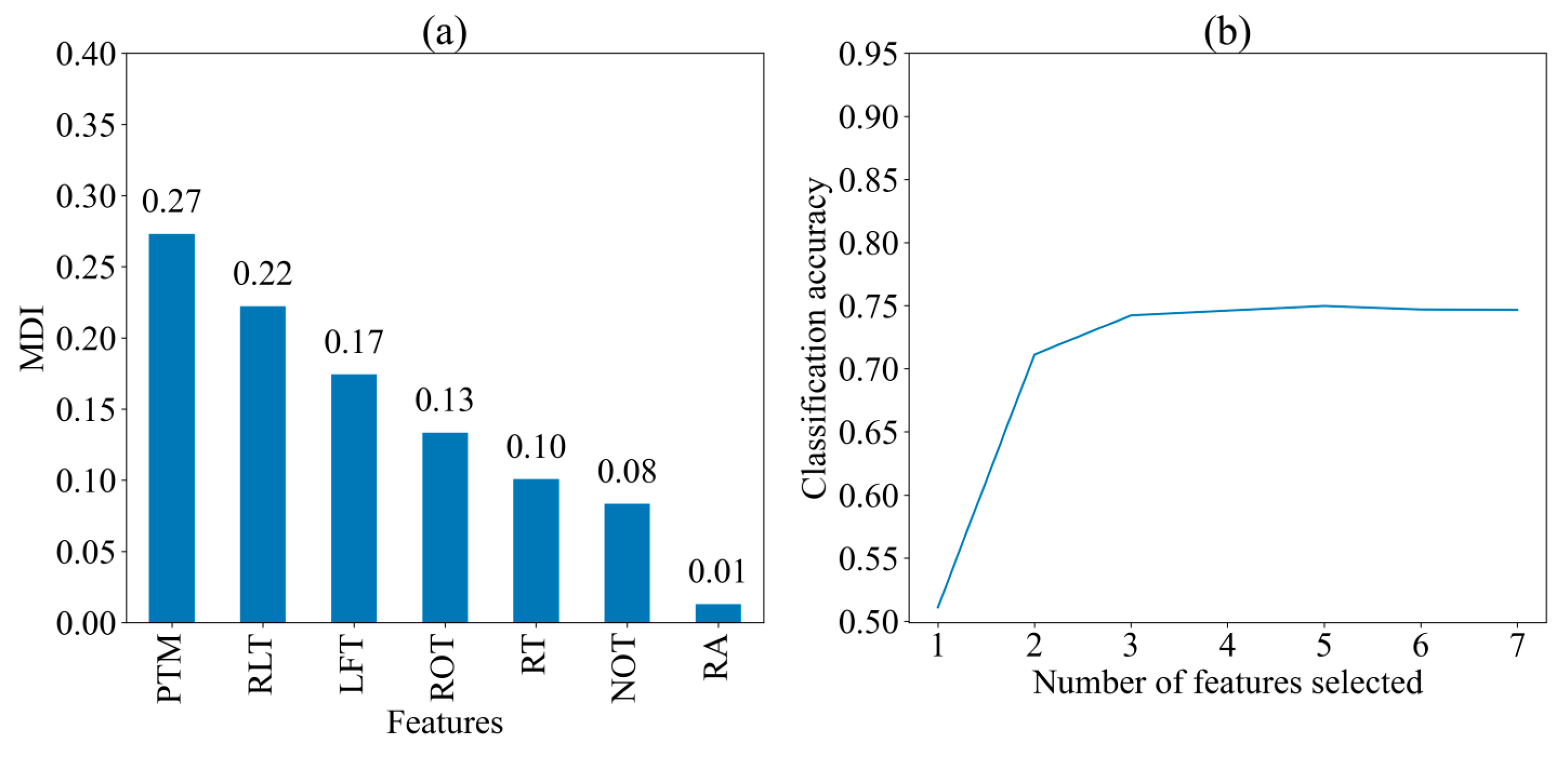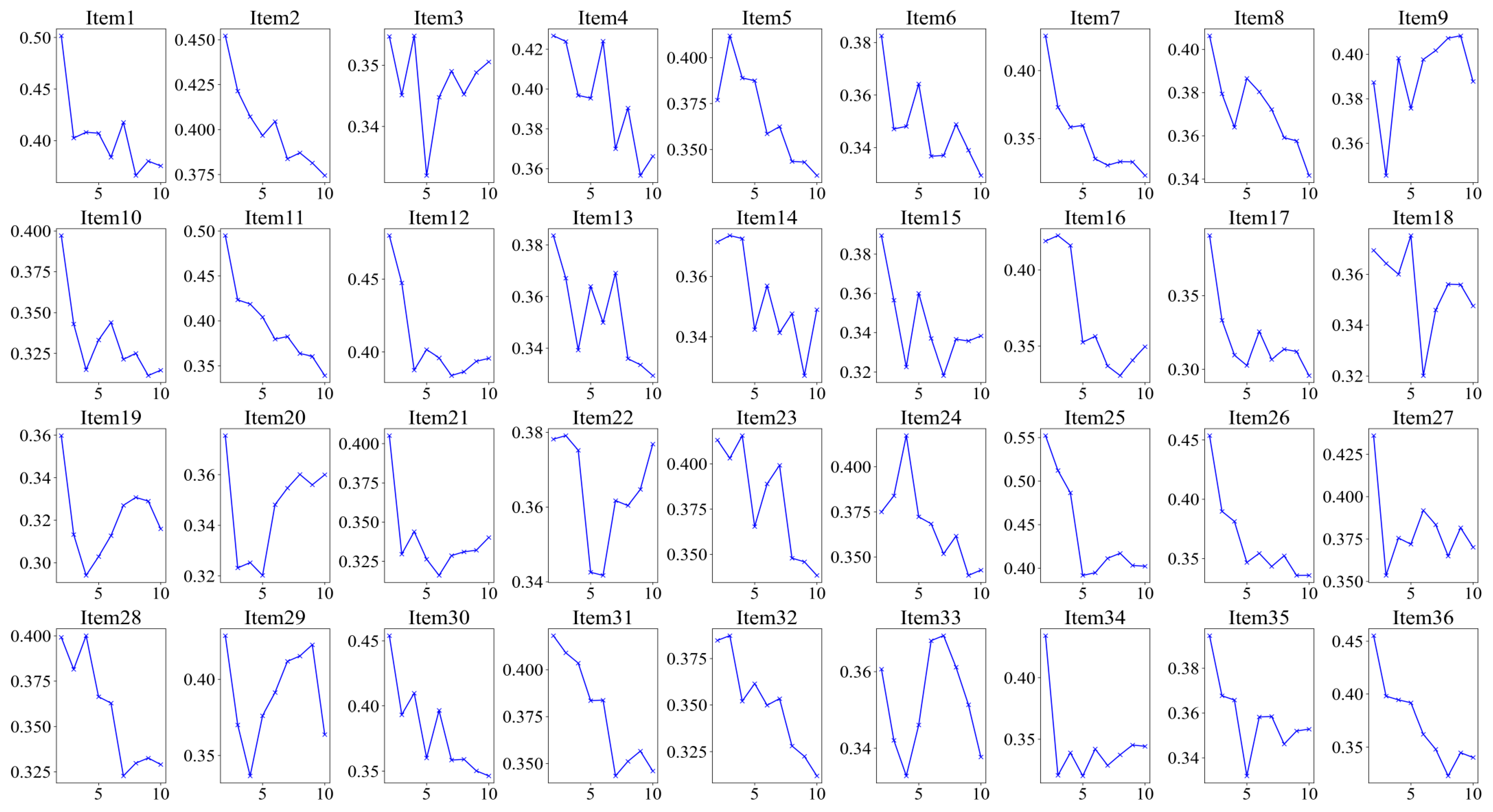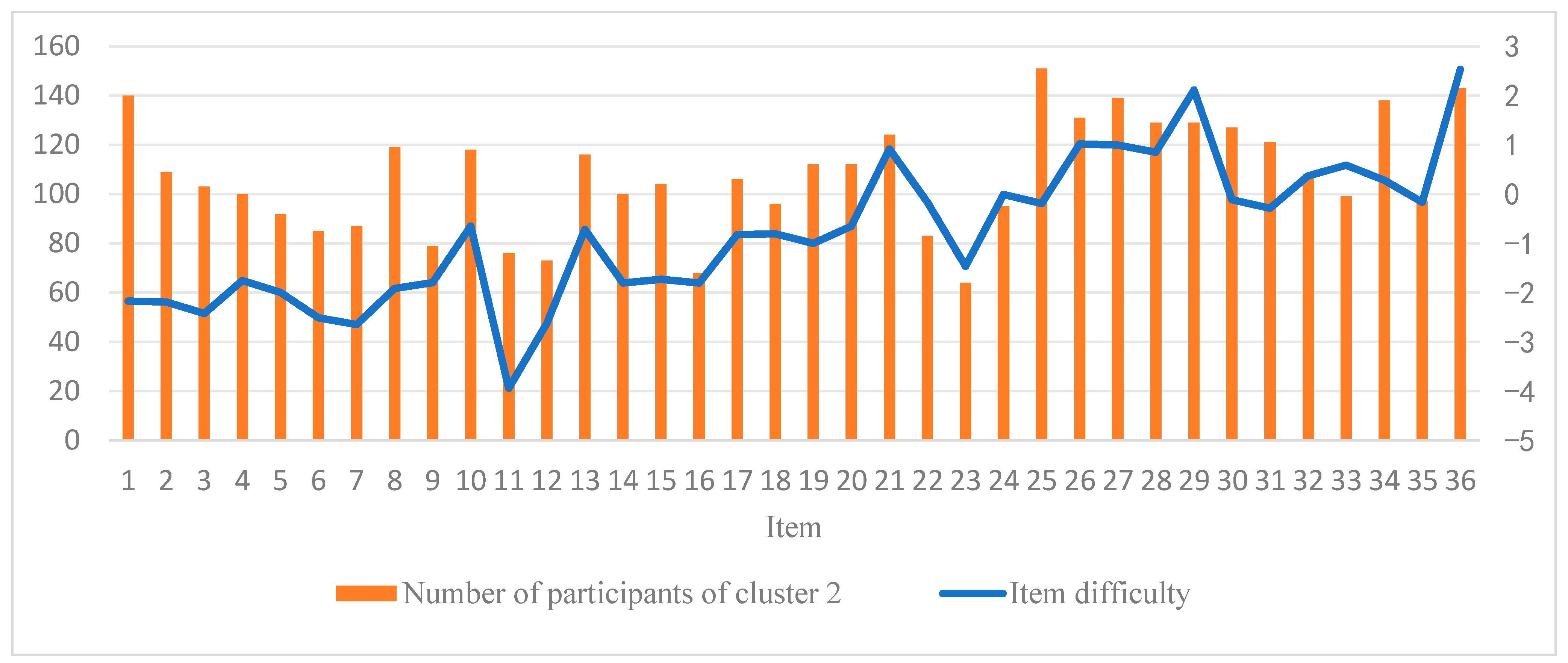Exploring Critical Eye-Tracking Metrics for Identifying Cognitive Strategies in Raven’s Advanced Progressive Matrices: A Data-Driven Perspective
Abstract
1. Introduction
2. Backgrounds
2.1. Three Cognitive Strategies in APM
2.2. Five Eye-Tracking Metrics
2.2.1. Proportional Time on Matrix (PTM)
2.2.2. Latency to First Toggle (LFT)
2.2.3. Rate of Latency to First Toggle (RLT)
2.2.4. Number of Toggles (NOT)
2.2.5. Rate of Toggling (ROT)
2.3. Multi-Strategy Eye-Tracking Model
2.4. Recursive Feature Elimination and Random Forest Algorithm
3. Empirical Study
3.1. Data Description
3.2. Analysis
- (1)
- Initialize the feature subset: An initial subset of k features was selected and input into a Random Forest model. Importance scores (i.e., MDI) for each feature were computed based on their contribution to reducing classification error across the ensemble of decision trees. To ensure a robust evaluation, 10-fold cross-validation was applied. In this method, the dataset was partitioned into ten equal parts (folds), with nine folds used for training and one for testing in each iteration, cycling through all ten folds. The average classification accuracy across these folds provided a reliable estimate of the performance of the initial feature subset.
- (2)
- Remove the least important feature: After computing the importance scores, the feature with the lowest importance was removed from the subset, resulting in a new subset of k − 1 features. This reduced subset was re-input into the Random Forest model, where importance scores were recalculated for the remaining features. Another round of 10-fold cross-validation was then performed on the updated subset to obtain a new mean classification accuracy score, allowing for the evaluation of model performance as the feature count was gradually reduced.
- (3)
- Perform the recursive process: Steps (1) and (2) were repeated iteratively, with the least important feature removed in each step until no features remained in the subset. This recursive elimination generated a sequence of k feature subsets, each containing progressively fewer features. For each subset, 10-fold cross-validation was performed, recording classification accuracy scores for all subsets to illustrate how model performance varied as features were removed. This systematic approach facilitated the identification of an optimal balance between model simplicity and predictive power.
- (4)
- Select the optimal feature combination: Choose the feature subset with the highest classification accuracy as the optimal feature combination.
4. Result
5. Conclusions and Discussion
5.1. Conclusions
5.2. Discussion
Author Contributions
Funding
Institutional Review Board Statement
Informed Consent Statement
Data Availability Statement
Conflicts of Interest
| 1 | A cut-off point of 0.5 was used for MEM, and then compared with the results of the K-means clustering. |
References
- Arendasy, Martin E., and Markus Sommer. 2013. Reducing response elimination strategies enhances the construct validity of figural matrices. Intelligence 41: 234–43. [Google Scholar] [CrossRef]
- Becker, Nicolas, Florian Schmitz, Anke M. Falk, Jasmin Feldbrügge, Daniel R. Recktenwald, Oliver Wilhelm, Franzis Preckel, and Frank M. Spinath. 2016. Preventing response elimination strategies improves the convergent validity of figural matrices. Journal of Intelligence 4: 2. [Google Scholar] [CrossRef]
- Bethell-Fox, Charles E., David F. Lohman, and Richard E. Snow. 1984. Adaptive reasoning: Componential and eye movement analysis of geometric analogy performance. Intelligence 8: 205–38. [Google Scholar] [CrossRef]
- Biau, Gérard, and Erwan Scornet. 2016. A random forest guided tour. Test 25: 197–227. [Google Scholar] [CrossRef]
- Breiman, Leo. 2001. Random forests. Machine Learning 45: 5–32. [Google Scholar] [CrossRef]
- Carpenter, Patricia A., Marcel A. Just, and Peter Shell. 1990. What one intelligence test measures: A theoretical account of the processing in the Raven Progressive Matrices test. Psychological Review 97: 404–31. [Google Scholar] [CrossRef]
- Chiu, Ivey, and Li H. Shu. 2010. Potential limitations of verbal protocols in design experiments. International Design Engineering Technical Conferences and Computers and Information in Engineering Conference 44137: 287–96. [Google Scholar]
- Darst, Burcu F., Kristen C. Malecki, and Corinne D. Engelman. 2018. Using recursive feature elimination in random forest to account for correlated variables in high dimensional data. BMC Genetics 19: 1–6. [Google Scholar] [CrossRef] [PubMed]
- Glady, Yannick, Robert M. French, and Jean-Pierre Thibaut. 2016. Comparing competing views of analogy making using eye-tracking technology. Paper presented at the Thirty-Eighth Annual Meeting of the Cognitive Science Society, Austin, TX, USA, August 10–13. [Google Scholar]
- Gonthier, Corentin, and Jean-Luc Roulin. 2020. Intraindividual strategy shifts in Raven’s matrices, and their dependence on working memory capacity and need for cognition. Journal of Experimental Psychology: General 149: 564. [Google Scholar] [CrossRef]
- Gonthier, Corentin, and Noémylle Thomassin. 2015. Strategy use fully mediates the relationship between working memory capacity and performance on Raven’s matrices. Journal of Experimental Psychology: General 144: 916–24. [Google Scholar] [CrossRef]
- Han, Zhuangzhuang, Qiwei He, and Matthias Von Davier. 2019. Predictive feature generation and selection using process data from PISA interactive problem-solving items: An application of random forests. Frontiers in Psychology 10: 2461. [Google Scholar] [CrossRef] [PubMed]
- Hayes, Taylor R., Alexander A. Petrov, and Per B. Sederberg. 2011. A novel method for analyzing sequential eye movements reveals strategic influence on Raven’s Advanced Progressive Matrices. Journal of Vision 11: 10. [Google Scholar] [CrossRef]
- Hayes, Taylor R., Alexander A. Petrov, and Per B. Sederberg. 2015. Do we really become smarter when our fluid-intelligence test scores improve? Intelligence 48: 1–14. [Google Scholar] [CrossRef]
- Hessels, Marco G. P., Katia Vanderlinden, and Hildalill Rojas. 2011. Training effects in dynamic assessment: A pilot study as eye movement as indicator of problem solving behavior before and after training. Educational and Child Psychology 28: 101–13. [Google Scholar] [CrossRef]
- Jamal, Suhaima, Meenalosini V. Cruz, Sibi Chakravarthy, Camden Wahl, and Hayden Wimmer. 2023. Integration of EEG and eye tracking technology: A systematic review. SoutheastCon 2023: 209–16. [Google Scholar]
- Jarosz, Andrew F., Megan J. Raden, and Jennifer Wiley. 2019. Working memory capacity and strategy use on the RAPM. Intelligence 77: 101387. [Google Scholar] [CrossRef]
- Laurence, Paulo G., and Elizeu C. Macedo. 2023. Cognitive strategies in matrix-reasoning tasks: State of the art. Psychonomic Bulletin and Review 30: 147–59. [Google Scholar] [CrossRef]
- Laurence, Paulo G., Tatiana P. Mecca, Alexandre Serpa, Romain Martin, and Elizeu C. Macedo. 2018. Eye movements and cognitive strategy in a fluid intelligence test: Item type analysis. Frontiers in Psychology 9: 380. [Google Scholar] [CrossRef]
- Lerman, Robert I., and Shlomo Yitzhaki. 1984. A note on the calculation and interpretation of the Gini index. Economics Letters 15: 363–68. [Google Scholar] [CrossRef]
- Li, Chenyu, Xuezhu Ren, Karl Schweizer, and Tengfei Wang. 2022. Strategy use moderates the relation between working memory capacity and fluid intelligence: A combined approach. Intelligence 91: 101627. [Google Scholar] [CrossRef]
- Liu, Yaohui, Perida Zhan, Yanbin Fu, Qipeng Chen, Kaiwen Man, and Yikun Luo. 2023. Using a multi-strategy eye-tracking psychometric model to measure intelligence and identify cognitive strategy in Raven’s advanced progressive matrices. Intelligence 100: 101782. [Google Scholar] [CrossRef]
- Loesche, Patrick. 2020. Raven’s Advanced Progressive Matrices. In Encyclopedia of Personality and Individual Differences. Edited by Virgil Zeigler-Hill and Todd K. Shackelford. Cham: Springer. [Google Scholar]
- Louppe, Gilles, Louis Wehenkel, Antonio Sutera, and Pierre Geurts. 2013. Understanding variable importances in forests of randomized trees. Advances in Neural Information Processing Systems 26: 431–39. [Google Scholar]
- Mitchum, Ainsley L., and Colleen M. Kelley. 2010. Solve the problem first: Constructive solution strategies can influence the accuracy of retrospective confidence judgments. Journal of Experimental Psychology: Learning, Memory, and Cognition 36: 699–710. [Google Scholar] [CrossRef]
- Niebaum, Jesse, and Yuko Munakata. 2023. The development of relational reasoning: An eyetracking analysis of strategy use and adaptation in children and adults performing matrix completion. Open Mind 7: 197–220. [Google Scholar] [CrossRef]
- Olukanmi, Peter, Fulufhelo Nelwamondo, Tshilidzi Marwala, and Bhekisipho Twala. 2022. Automatic detection of outliers and the number of clusters in k-means clustering via Chebyshev-type inequalities. Neural Computing and Applications 34: 5939–58. [Google Scholar] [CrossRef]
- Pedregosa, Fabian, Gaël Varoquaux, Alexandre Gramfort, Vincent Michel, Bertrand Thirion, Olivier Grisel, Mathieu Blondel, Peter Prettenhofer, Ron Weiss, Vincent Dubourg, and et al. 2011. Scikit-learn: Machine Learning in Python. Journal of Machine Learning Research 12: 2825–30. [Google Scholar]
- Plummer, Martyn. 2012. JAGS Version 3.3.0 User Manual. Pittsburgh: Carnegie Mellon University. [Google Scholar]
- Raden, Megan J., and Andrew F. Jarosz. 2022. Strategy transfer on fluid reasoning tasks. Intelligence 91: 101618. [Google Scholar] [CrossRef]
- Raven, John, John C. Raven, and John H. Court. 1998. Manual for Raven’s Progressive Matrices and Vocabulary Scales. Oxford: Oxford Psychologists Press. [Google Scholar]
- Rigatti, Steven J. 2017. Random forest. Journal of Insurance Medicine 47: 31–39. [Google Scholar] [CrossRef]
- Rivollier, Guillaume, Jean-Charles Quinton, Corentin Gonthier, and Annique Smeding. 2021. Looking with the (computer) mouse: How to unveil problem-solving strategies in matrix reasoning without eye-tracking. Behavior Research Methods 53: 1081–96. [Google Scholar] [CrossRef]
- Rousseeuw, Peter J. 1987. Silhouettes: A graphical aid to the interpretation and validation of cluster analysis. Journal of Computational and Applied Mathematics 20: 53–65. [Google Scholar] [CrossRef]
- Snow, Richard E. 1980. Aptitude processes. In Aptitude, Learning, and Instruction: Cognitive Process Analysis of Aptitude. Edited by Pat-Anthony Federico and William E. Montague. London: Routledge, pp. 27–63. [Google Scholar]
- Sukantarat, K.T., P. W. Burgess, R. C. N. Williamson, and S. J. Brett. 2005. Prolonged cognitive dysfunction in survivors of critical illness. Anaesthesia 60: 847–53. [Google Scholar] [CrossRef] [PubMed]
- Thibaut, Jean-Pierre, Robert M. French, Angelique Missault, Yannick Gérard, and Yannick Glady. 2011. In the Eyes of the Beholder: What Eye-Tracking Reveals About Analogy-Making Strategies in Children and Adults. Annual Meeting of the Cognitive Science Society 33: 453–58. [Google Scholar]
- Vakil, Eli, and Hefziba Lifshitz-Zehavi. 2012. Solving the Raven Progressive Matrices by adults with intellectual disability with/without Down syndrome: Different cognitive patterns as indicated by eye-movements. Research in Developmental Disabilities 33: 645–54. [Google Scholar] [CrossRef]
- Vigneau, François, André F. Caissie, and Douglas A. Bors. 2006. Eye-movement analysis demonstrates strategic influences on intelligence. Intelligence 34: 261–72. [Google Scholar] [CrossRef]
- Wang, Zhimou, and Peida Zhan. 2024. Eye-Tracking-Based Hidden Markov Modeling for Revealing within-Item Cognitive Strategy Switching. PsyArXiv. [Google Scholar] [CrossRef]
- Wang, Zhimou, Yaohu Liu, and Peida Zhan. 2024. Using a deep learning-based visual computational model to identify cognitive strategies in matrix reasoning. Journal of Educational and Behavioral Statistics. Online First Publication. [Google Scholar] [CrossRef]
- Zhu, Ling, and Jiufang Lv. 2023. Review of studies on user research based on EEG and eye tracking. Applied Sciences 13: 6502. [Google Scholar] [CrossRef]










Disclaimer/Publisher’s Note: The statements, opinions and data contained in all publications are solely those of the individual author(s) and contributor(s) and not of MDPI and/or the editor(s). MDPI and/or the editor(s) disclaim responsibility for any injury to people or property resulting from any ideas, methods, instructions or products referred to in the content. |
© 2025 by the authors. Licensee MDPI, Basel, Switzerland. This article is an open access article distributed under the terms and conditions of the Creative Commons Attribution (CC BY) license (https://creativecommons.org/licenses/by/4.0/).
Share and Cite
Liu, Y.; He, K.; Man, K.; Zhan, P. Exploring Critical Eye-Tracking Metrics for Identifying Cognitive Strategies in Raven’s Advanced Progressive Matrices: A Data-Driven Perspective. J. Intell. 2025, 13, 14. https://doi.org/10.3390/jintelligence13020014
Liu Y, He K, Man K, Zhan P. Exploring Critical Eye-Tracking Metrics for Identifying Cognitive Strategies in Raven’s Advanced Progressive Matrices: A Data-Driven Perspective. Journal of Intelligence. 2025; 13(2):14. https://doi.org/10.3390/jintelligence13020014
Chicago/Turabian StyleLiu, Yaohui, Keren He, Kaiwen Man, and Peida Zhan. 2025. "Exploring Critical Eye-Tracking Metrics for Identifying Cognitive Strategies in Raven’s Advanced Progressive Matrices: A Data-Driven Perspective" Journal of Intelligence 13, no. 2: 14. https://doi.org/10.3390/jintelligence13020014
APA StyleLiu, Y., He, K., Man, K., & Zhan, P. (2025). Exploring Critical Eye-Tracking Metrics for Identifying Cognitive Strategies in Raven’s Advanced Progressive Matrices: A Data-Driven Perspective. Journal of Intelligence, 13(2), 14. https://doi.org/10.3390/jintelligence13020014




